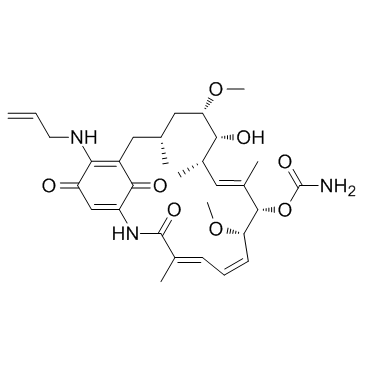17-AAG

17-AAG structure
|
Common Name | 17-AAG | ||
|---|---|---|---|---|
| CAS Number | 75747-14-7 | Molecular Weight | 585.688 | |
| Density | 1.2±0.1 g/cm3 | Boiling Point | 797.8±60.0 °C at 760 mmHg | |
| Molecular Formula | C31H43N3O8 | Melting Point | 201-203ºC | |
| MSDS | USA | Flash Point | 436.3±32.9 °C | |
|
Interactome analysis of the human respiratory syncytial virus RNA polymerase complex identifies protein chaperones as important cofactors that promote L-protein stability and RNA synthesis.
J. Virol. 89(2) , 917-30, (2015) The human respiratory syncytial virus (HRSV) core viral RNA polymerase comprises the large polymerase protein (L) and its cofactor, the phosphoprotein (P), which associate with the viral ribonucleoprotein complex to replicate the genome and, together with the... |
|
|
HGUE-C-1 is an atypical and novel colon carcinoma cell line.
BMC Cancer 15 , 240, (2015) Colorectal carcinoma is a common cause of cancer. Adjuvant treatments include: 5-fluorouracil administered together with folinic acid, or more recently, oral fluoropyrimidines such as capecitabine, in combination with oxaliplatin or irinotecan. Metastatic col... |
|
|
Comparative Study of 17-AAG and NVP-AUY922 in Pancreatic and Colorectal Cancer Cells: Are There Common Determinants of Sensitivity?
Transl. Oncol. 7(5) , 590-604, (2014) The use of heat shock protein 90 (Hsp90) inhibitors is an attractive antineoplastic therapy. We wanted to compare the effects of the benzoquinone 17-allylamino-17-demethoxygeldanamycin (17-AAG, tanespimycin) and the novel isoxazole resorcinol-based Hsp90 inhi... |
|
|
Quantitative proteomics of the yeast Hsp70/Hsp90 interactomes during DNA damage reveal chaperone-dependent regulation of ribonucleotide reductase.
J. Proteomics 112 , 285-300, (2015) The highly conserved molecular chaperones Hsp90 and Hsp70 are indispensible for folding and maturation of a significant fraction of the proteome, including many proteins involved in signal transduction and stress response. To examine the dynamics of chaperone... |
|
|
Translational downregulation of HSP90 expression by iron chelators in neuroblastoma cells.
Mol. Pharmacol. 87(3) , 513-24, (2015) Iron is an essential cellular nutrient, being a critical cofactor of several proteins involved in cell growth and replication. Compared with normal cells, neoplastic cells have been shown to require a greater amount of iron, thus laying the basis for the prom... |
|
|
Proteomic analysis of mitochondria in respiratory epithelial cells infected with human respiratory syncytial virus and functional implications for virus and cell biology.
J. Pharm. Pharmacol. 67(3) , 300-18, (2015) The aim of this study was to quantitatively characterise the mitochondrial proteome of airway epithelial cells infected with human respiratory syncytial virus (HRSV), a major cause of paediatric illness.Quantitative proteomics, underpinned by stable isotope l... |
|
|
Serotonergic signalling suppresses ataxin 3 aggregation and neurotoxicity in animal models of Machado-Joseph disease.
Brain 138 , 3221-37, (2015) Polyglutamine diseases are a class of dominantly inherited neurodegenerative disorders for which there is no effective treatment. Here we provide evidence that activation of serotonergic signalling is beneficial in animal models of Machado-Joseph disease. We ... |
|
|
Multi-faceted proteomic characterization of host protein complement of Rift Valley fever virus virions and identification of specific heat shock proteins, including HSP90, as important viral host factors.
PLoS ONE 9(5) , e93483, (2014) Rift Valley fever is a potentially fatal disease of humans and domestic animals caused by Rift Valley fever virus (RVFV). Infection with RVFV in ruminants can cause near 100% abortion rates and recent outbreaks in naïve human populations have suggested case f... |
|
|
The novel HSP90 inhibitor AT13387 potentiates radiation effects in squamous cell carcinoma and adenocarcinoma cells.
Oncotarget 6 , 35652-66, (2015) Overexpression of heat shock protein 90 (HSP90) is associated with increased tumor cell survival and radioresistance. In this study we explored the efficacy of the novel HSP90 inhibitor AT13387 and examined its radiosensitizing effects in combination with gam... |
|
|
A Tetrahymena Hsp90 co-chaperone promotes siRNA loading by ATP-dependent and ATP-independent mechanisms.
EMBO J. 34(4) , 559-77, (2015) The loading of small interfering RNAs (siRNAs) and microRNAs into Argonaute proteins is enhanced by Hsp90 and ATP in diverse eukaryotes. However, whether this loading also occurs independently of Hsp90 and ATP remains unclear. We show that the Tetrahymena Hsp... |